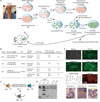Human COL7A1-corrected induced pluripotent stem cells for the treatment of recessive dystrophic epidermolysis bullosa
- PMID: 25429056
- PMCID: PMC4428910
- DOI: 10.1126/scitranslmed.3009540
Human COL7A1-corrected induced pluripotent stem cells for the treatment of recessive dystrophic epidermolysis bullosa
Erratum in
- Sci Transl Med. 2014 Dec 17;6(267):267er8. Derafshi, Bahareh Haddad [corrected to Haddad, Bahareh]
Abstract
Patients with recessive dystrophic epidermolysis bullosa (RDEB) lack functional type VII collagen owing to mutations in the gene COL7A1 and suffer severe blistering and chronic wounds that ultimately lead to infection and development of lethal squamous cell carcinoma. The discovery of induced pluripotent stem cells (iPSCs) and the ability to edit the genome bring the possibility to provide definitive genetic therapy through corrected autologous tissues. We generated patient-derived COL7A1-corrected epithelial keratinocyte sheets for autologous grafting. We demonstrate the utility of sequential reprogramming and adenovirus-associated viral genome editing to generate corrected iPSC banks. iPSC-derived keratinocytes were produced with minimal heterogeneity, and these cells secreted wild-type type VII collagen, resulting in stratified epidermis in vitro in organotypic cultures and in vivo in mice. Sequencing of corrected cell lines before tissue formation revealed heterogeneity of cancer-predisposing mutations, allowing us to select COL7A1-corrected banks with minimal mutational burden for downstream epidermis production. Our results provide a clinical platform to use iPSCs in the treatment of debilitating genodermatoses, such as RDEB.
Copyright © 2014, American Association for the Advancement of Science.
Figures





Similar articles
-
Genetically corrected iPSCs as cell therapy for recessive dystrophic epidermolysis bullosa.Sci Transl Med. 2014 Nov 26;6(264):264ra165. doi: 10.1126/scitranslmed.3010083. Sci Transl Med. 2014. PMID: 25429058
-
Footprint-free gene mutation correction in induced pluripotent stem cell (iPSC) derived from recessive dystrophic epidermolysis bullosa (RDEB) using the CRISPR/Cas9 and piggyBac transposon system.J Dermatol Sci. 2020 Jun;98(3):163-172. doi: 10.1016/j.jdermsci.2020.04.004. Epub 2020 Apr 24. J Dermatol Sci. 2020. PMID: 32376152
-
Base Editor Correction of COL7A1 in Recessive Dystrophic Epidermolysis Bullosa Patient-Derived Fibroblasts and iPSCs.J Invest Dermatol. 2020 Feb;140(2):338-347.e5. doi: 10.1016/j.jid.2019.07.701. Epub 2019 Aug 19. J Invest Dermatol. 2020. PMID: 31437443 Free PMC article.
-
Gene therapy: pursuing restoration of dermal adhesion in recessive dystrophic epidermolysis bullosa.Exp Dermatol. 2014 Jan;23(1):1-6. doi: 10.1111/exd.12246. Exp Dermatol. 2014. PMID: 24107073 Review.
-
Gene editing toward the use of autologous therapies in recessive dystrophic epidermolysis bullosa.Transl Res. 2016 Feb;168:50-58. doi: 10.1016/j.trsl.2015.05.008. Epub 2015 May 27. Transl Res. 2016. PMID: 26073463 Free PMC article. Review.
Cited by
-
Context-Dependent Strategies for Enhanced Genome Editing of Genodermatoses.Cells. 2020 Jan 2;9(1):112. doi: 10.3390/cells9010112. Cells. 2020. PMID: 31906492 Free PMC article. Review.
-
Differentiation of Human Induced Pluripotent Stem Cells into Keratinocytes.Curr Protoc. 2022 Apr;2(4):e408. doi: 10.1002/cpz1.408. Curr Protoc. 2022. PMID: 35384405 Free PMC article.
-
Direct somatic lineage conversion.Philos Trans R Soc Lond B Biol Sci. 2015 Oct 19;370(1680):20140368. doi: 10.1098/rstb.2014.0368. Philos Trans R Soc Lond B Biol Sci. 2015. PMID: 26416679 Free PMC article. Review.
-
Expansion and Purification Are Critical for the Therapeutic Application of Pluripotent Stem Cell-Derived Myogenic Progenitors.Stem Cell Reports. 2017 Jul 11;9(1):12-22. doi: 10.1016/j.stemcr.2017.04.022. Epub 2017 May 18. Stem Cell Reports. 2017. PMID: 28528701 Free PMC article.
-
Venturing into the New Science of Nucleases.J Invest Dermatol. 2016 Apr;136(4):742-745. doi: 10.1016/j.jid.2016.01.021. J Invest Dermatol. 2016. PMID: 27012560 Free PMC article.
References
-
- Fine JD, Bruckner-Tuderman L, Eady RA, Bauer EA, Bauer JW, Has C, Heagerty A, Hintner H, Hovnanian A, Jonkman MF, Leigh I, Marinkovich MP, Martinez AE, McGrath JA, Mellerio JE, Moss C, Murrell DF, Shimizu H, Uitto J, Woodley D, Zambruno G. Inherited epidermolysis bullosa: Updated recommendations on diagnosis and classification. J. Am. Acad. Dermatol. 2014;70:1103–1126. - PubMed
-
- Arbuckle HA. Epidermolysis bullosa care in the United States. Dermatol. Clin. 2010;28:387–389. - PubMed
-
- Fine JD, Johnson LB, Suchindran C, Bauer EA, Carter M, McGuire J, Moshell A. In: Epidermolysis Bullosa. Clinical, Epidemiologic and Laboratory Advances and the Findings of the National Epidermolysis Bullosa Registry. Fine JD, Bauer EA, McGuire J, Moshell A, editors. Baltimore, MD: The Johns Hopkins University Press; 1999. pp. 175–192.
-
- Chen M, Kasahara N, Keene DR, Chan L, Hoeffler WK, Finlay D, Barcova M, Cannon PM, Mazurek C, Woodley DT. Restoration of type VII collagen expression and function in dystrophic epidermolysis bullosa. Nat. Genet. 2002;32:670–675. - PubMed
-
- Mecklenbeck S, Compton SH, Mejfa JE, Cervini R, Hovnanian A, Bruckner-Tuderman L, Barrandon Y. A microinjected COL7A 7-PAC vector restores synthesis of intact procollagen VII in a dystrophic epidermolysis bullosa keratinocyte cell line. Hum. Gene Ther. 2002;13:1655–1662. - PubMed
Publication types
MeSH terms
Substances
Grants and funding
LinkOut - more resources
Full Text Sources
Other Literature Sources

